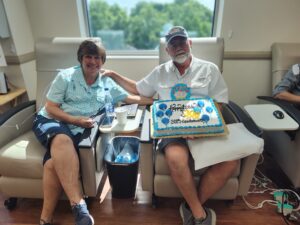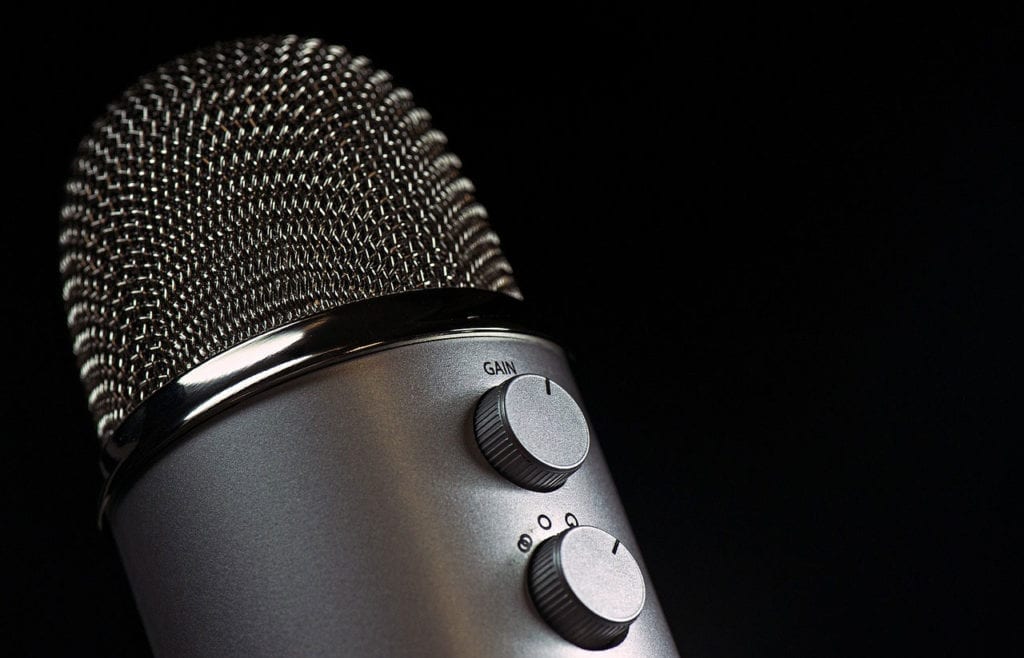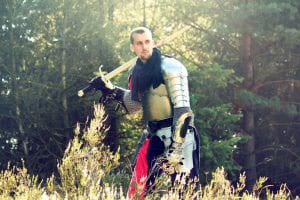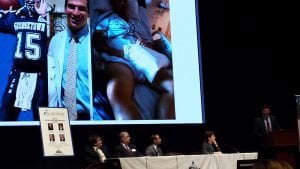
Rare Community Profiles is a Patient Worthy article series of long-form interviews featuring various stakeholders in the rare disease community, such as patients, their families, advocates, scientists, and more.
The Third Elephant on the Ramp to the Ark: How Carl’s Advocacy Affected His iMCD Journey
When Carl G. met his first wife in high school, he was smitten. The pair fell deeply in love and, despite attending separate colleges, married soon after. Building a life together was joyful and exciting. First came upward mobility in their careers; later came two beautiful children: a son and a daughter. Life was going great. By the time their children reached high school, Carl and his wife had just completed building their dream home.
In 2000, 24 years after they married, Carl’s wife was diagnosed with stage IV ovarian cancer. Their lives turned suddenly and unexpectedly upside down. Carl found himself thrust into the role of a cancer caregiver—a role he took on wholeheartedly. He would do anything for his wife.
After multiple major surgeries, repeated rounds of chemotherapy, and a valiantly fought four-year battle— “We’re Christians,” Carl says, “so we say she won her battle.”—Carl’s wife passed away in November 2004.
For years, while caring for his wife, Carl had been dealing with a few “red flags,” some minor annoyances. He perspired more than normal, but just assumed it was the way his body was. At one point, feeling sweaty and fatigued, he even visited the doctor. Says Carl:
“My doctor said, ‘Look, you were strong and healthy, but your wife went through cancer. You’re tired.’”
But Carl wasn’t sure. Something seemed off. And when his legs began burning while he was hunting with a friend, the feeling only intensified. Then came the drenching night sweats—Carl often had to change his sheets twice in one night—and the weight loss. By the time he woke up with golf ball-sized lymph nodes, he could no longer brush off his symptoms.
His family physician took one look at him and scheduled a biopsy for that day. The hospital removed a lymph node out of his left groin. The proposed diagnosis? Potential cancer. Yet a relatively new physician had other ideas. With a smile, Carl shares:
“To tell you how I’ve been blessed – I was at this small community hospital with two pathologists who had never seen anything like my biopsy. They had just hired a third pathologist who had just graduated and literally started there that week. He thought he had seen it before, spent a few hours going through his textbook from Ohio State, and found the chapter with the picture. Then he diagnosed me with Castleman disease.”
What is Castleman Disease?
Also known as: Castleman’s disease; Castleman tumor; Giant lymph node hyperplasia
Castleman disease is a rare disorder which causes abnormal cell growth, leading to the formation of non-cancerous tumors and enlarged lymph nodes. This disorder is considered either unicentric (localized to one lymph node) or multicentric (affecting multiple, or every, lymph node). Carl has multicentric Castleman disease, meaning he has widespread lymph node involvement. He says:
“In many individuals with unicentric Castleman disease, doctors simply remove the affected lymph node. They couldn’t do that for me.”
Right now, the cause of Castleman disease is unknown. One hypothesis posits that interleukin-6 (IL-6) is overproduced in the body, causing cell overgrowth.
Other hypotheses suggest that HIV or herpesvirus 8 (HHV-8) infection correlates with Castleman disease. Nearly all people with HIV have HHV-8. During his diagnostic odyssey, Carl was actually told that he was HIV-positive, though this was later determined not to be true. Even without HIV, an estimated 40-50% of people with multicentric Castleman disease do have HHV-8. But the correlation between HHV-8 and Castleman disease formation is not understood.
Cases, like Carl’s, that do not fit into HHV-8 associated multicentric Castleman disease are known as idiopathic multicentric Castleman disease (iMCD).
Identifying Castleman Disease
While unicentric Castleman disease is often asymptomatic, multicentric Castleman disease usually causes symptoms such as:
- Fatigue and general weakness
- Unintentional weight loss
- Nerve damage in the limbs from lack of oxygen
- Drenching night sweats
- An enlarged spleen and liver (hepatosplenomegaly)
- Fever
- Enlarged lymph nodes in the armpit, neck, collarbone, or groin
Treating the iMCD Subtype of Castleman Disease
Without treatment, Castleman disease may progress to non-Hodgkin’s lymphoma or other serious comorbidities. The current treatment option for iMCD is Sylvant (siltuximab) though corticosteroids, rituximab, and sirolimus may be used for those who do not respond to Sylvant.
When Carl was diagnosed, however, these treatment options did not exist. In fact, there was not even a code for Castleman disease in the insurance system; doctors used to have to put that Carl had non-Hodgkin’s lymphoma.
He remembers how his family physician told him that he would need to see an oncologist for a chemotherapy cocktail similar to what his wife had received during her cancer treatment. Even with that cocktail, the physician said, Carl would only survive for two years.
Looking for a second opinion, he visited the same oncologist his wife had seen for more information. As the oncologist looked up Castleman disease online, he came to the same conclusion: Carl had to take chemotherapy and his lifespan was significantly shorter. But Carl refused to take this as fact:
“I even called the Ohio State University Cancer Center. They gave me the same news, but also told me that they only treated unicentric Castleman disease, not multicentric. It really bothered me that doctors didn’t know anything about my condition and weren’t willing to work with me. So I sat down at my computer, found the world’s leading expert in multicentric Castleman disease in Little Rock, Arkansas, and sent him an email at 10:30 pm.”
15 minutes later, the specialist called Carl back with some promising news:
“We spent an hour on the phone talking about the need for more testing. He also told me my past doctors were wrong, that there was a study about to start for a new drug. I stopped him because my wife had been on a trial and nobody knew how drugs would work. He told me he was pretty confident that this trial would be successful.”
By the next week, after Carl had flown out to Little Rock for more tests, the doctor told Carl that he would be a prime candidate for the clinical trial. The drug being trialed? Sylvant. And Carl was the third person enrolled.
A Life-Changing Trial
During the first portion of the trial, Carl required intravenous treatment every other week; treatment sessions lasted for three hours at a time, though the treatment burden has since been reduced to one hour of treatment every three weeks.
The therapy, which was approved 10 years ago, has completely changed his life. Within the first three treatments, his symptoms gradually resolved. Now, he shares:
“I have no side effects whatsoever. I don’t get colds. Pretty much any virus stays away from me. The doctor can’t say if I’m cured or not, but I’ll continue to receive Sylvant in the future to maintain my health.”
After the drug developers heard Carl’s story, they flew him to Johnson & Johnson headquarters (J&J was developing the treatment at the time). He remembers meeting the researcher who began developing the treatment. When Carl stuck out his hand to thank him, the researcher instead enveloped Carl in a hug:
“He just put his arms around me and started to cry. He had been working to develop this drug for 15 years, and I was there because of his work. It was just such a profound moment. Later, when we got to talking, I asked what the drug was made of. He looked me right in the eyes and said, ‘Well, it’s made from the ovaries of Chinese mice.’ I couldn’t stop laughing. I looked him right back in the eyes and said, ‘That explains a lot. I’ve been craving cheese!’”
Today, for all intents and purposes, Carl lives a relatively normal life—outside of every third week when he undergoes treatment. His ability to be there for his family is incredibly important to him, especially as his current wife finishes up her treatment for breast cancer.

The Third Elephant
When he looks back at his experiences, Carl can’t help but think how impactful his self-advocacy has been. He encourages other individuals going through rare and chronic disease journeys to stand up for themselves:
“It’s important for patients to manage their own care. Ask questions. If the doctor doesn’t know, you have to do your own research or find another doctor. Don’t assume that your doctor is going to manage your health. I’ve seen so many patients who go to the doctor and whatever their doctor says is fine with them. Maybe, but maybe not. What if I hadn’t pushed when my doctor told me I’d be dead in two years? You have to make a decision. Do you want to fight or not? Do you want to try to live or not? The will to live is the most powerful medicine we have. I told God if I’m ready to go, I’m ready to go, but I’m selfish and I’d like to stick around.
I spoke at a conference this spring where I put it like this: if you’re the third elephant on the ramp to the Ark, what are you going to do? We’re the third elephant a lot of times, especially with a family and kids. But in this case, with your health, what are you going to do? Walk on? Walk off? I made the decision that I’m going to get on that Ark. I’m going to fight.”
But while your own fight and will to live are undoubtedly important, you are not alone in your struggles. If you have Castleman disease and are looking for support, or to contribute to research, there are options: Carl even submitted blood samples to Dr. David Fajgenbaum, who himself has iMCD. Says Carl:
“Reading Dr. Fajgenbaum’s Chasing My Cure was an amazing experience. Read it. He has done tons of research to try to find a cure. The drug he has worked on didn’t work 100% for everybody—it didn’t work for him—but he’s tirelessly working to change this field. And if you’re looking for resources, there is nowhere better to go than the Castleman Disease Collaborative Network.”
For more on Carl’s story and experience with iMCD, check out his video shared on the Know iMCD website.








